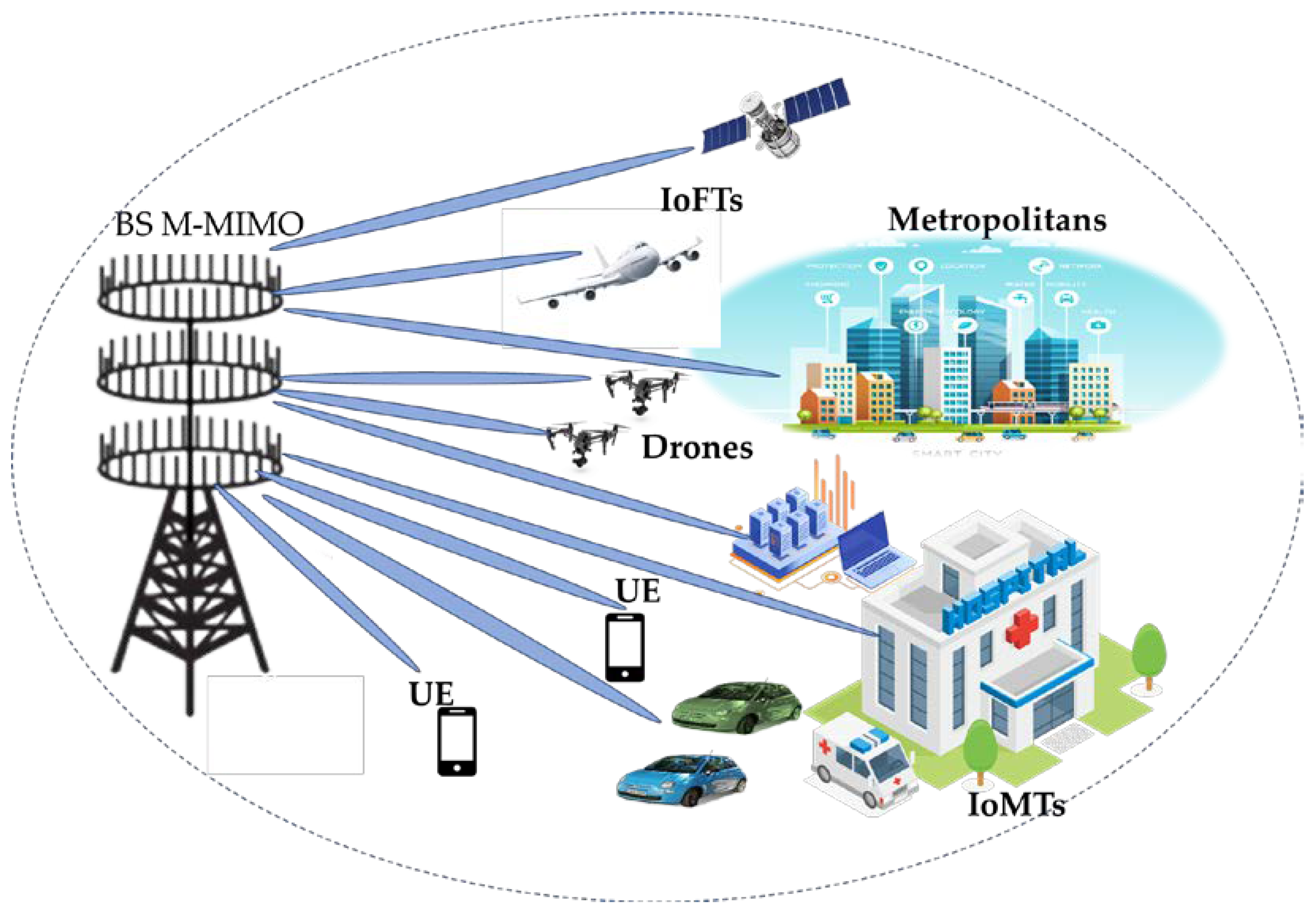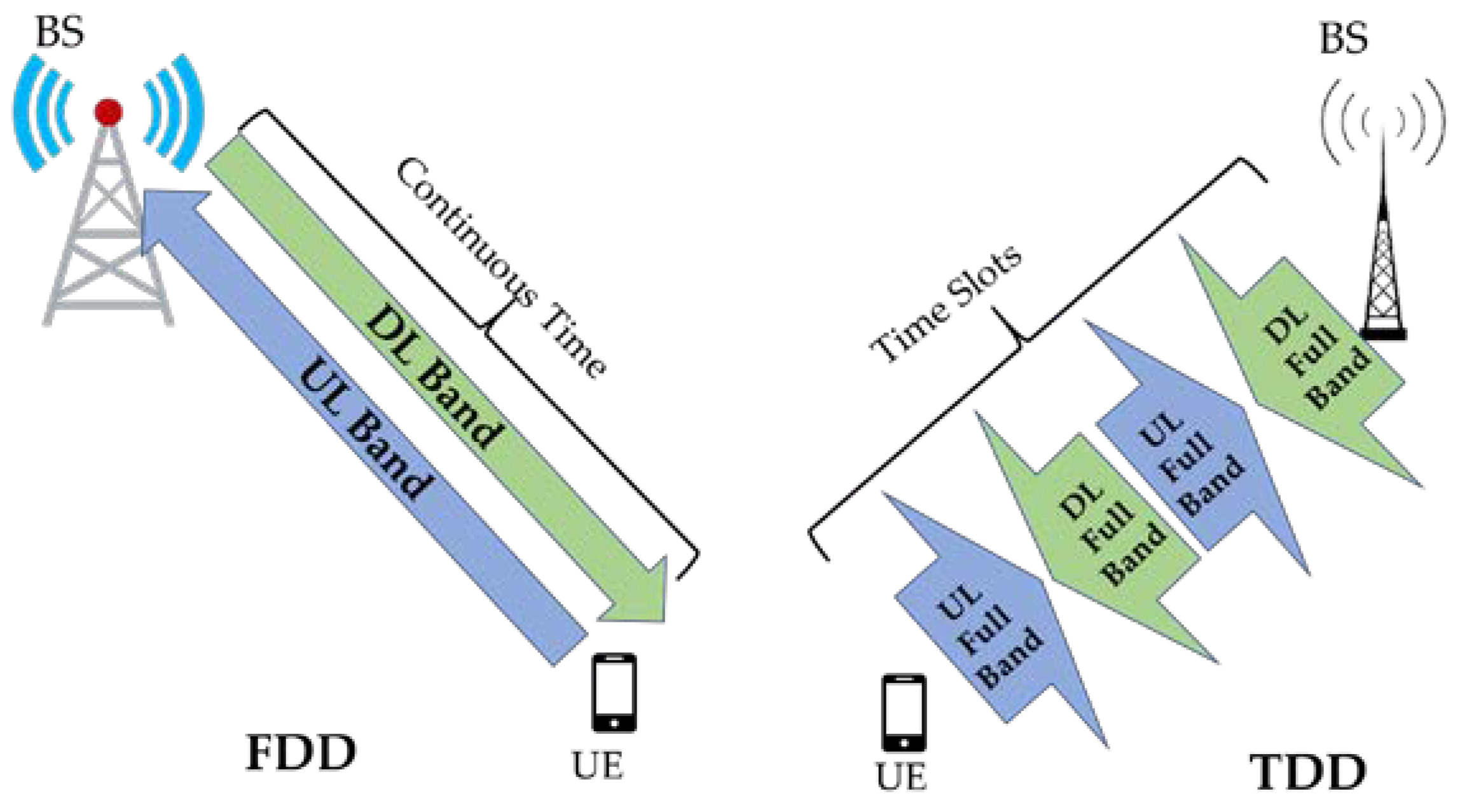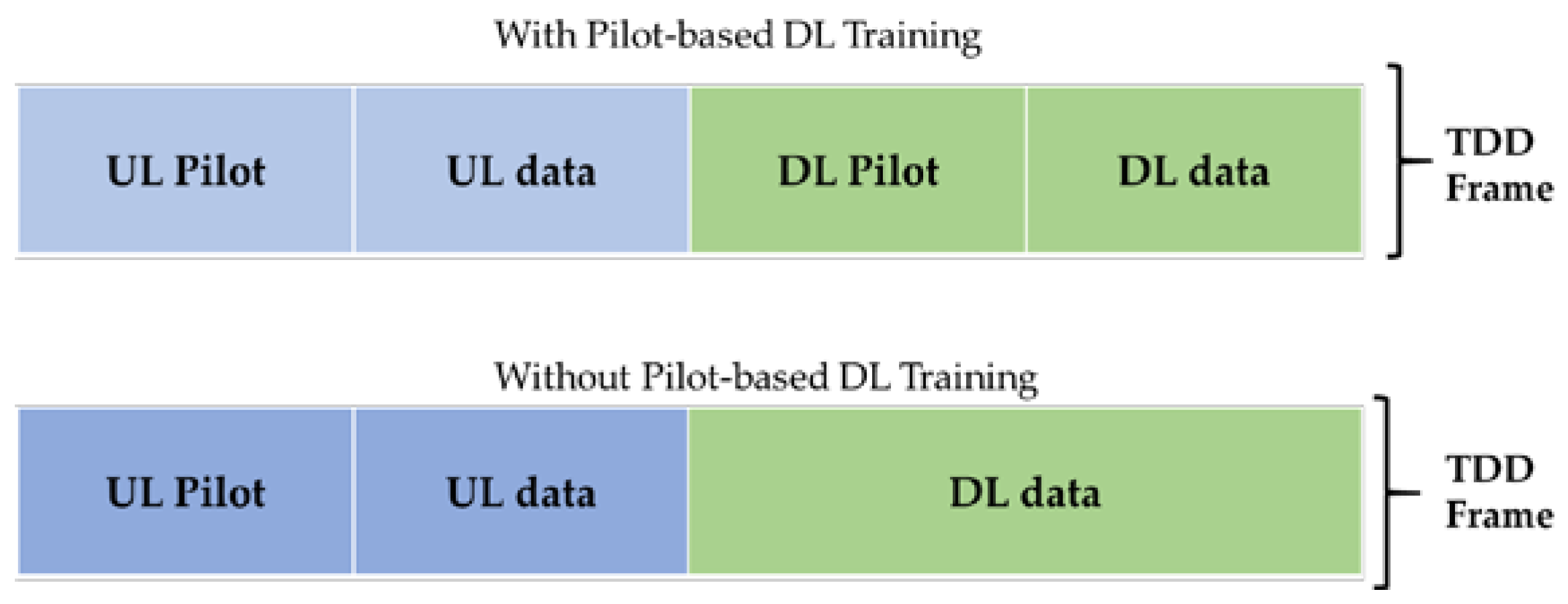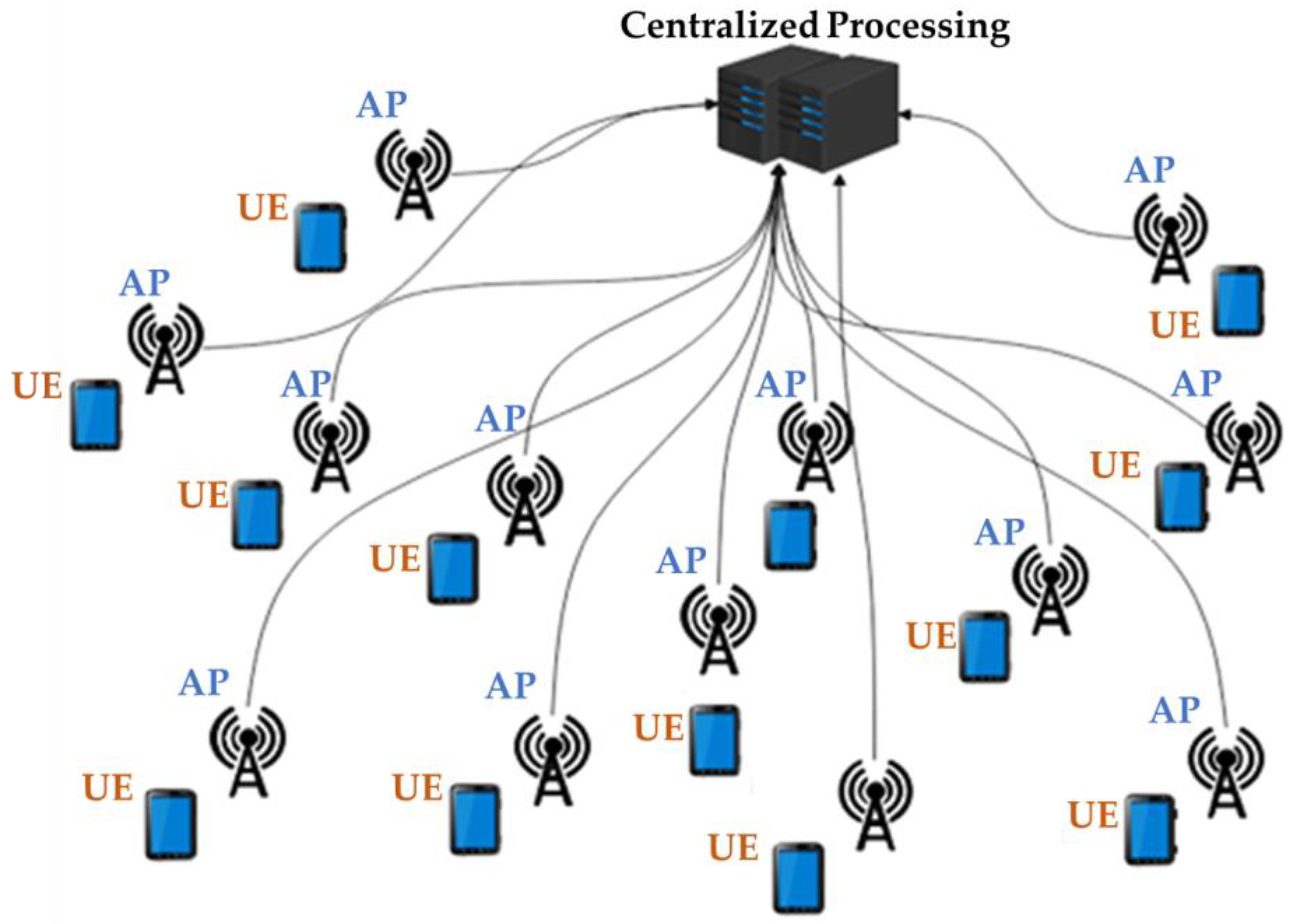1. Introduction
The modern digital era has involved the proliferation of intelligent appliances and smart special-purpose computers by technological information organizations, industrial corporations, and individuals
[1]. Wireless smart products generate enormous amounts of data through sensors and metal detector nodes in the process of mobilizing users’ everyday routines
[2]. The global amount of mobile data was calculated at 7.462 EB/month in 2010, and the estimators hypothetically believe it could reach 5016 EB/month by 2030
[3]. The current 5G mobile networks are densely heterogeneous in nature, with multiple modes and variously sized wireless devices linked via one unified air interface tailored for user-centric services
[4]. The unprecedented and radical changes in the requests for wireless user data services and the involvement of low-to-high-scale intelligent devices have tremendously increased the current network load and management challenges. Modern wireless networks require new technologies that can handle the current network load, interact with the environment proficiently, deliver instantaneous responses within very short intervals, and avoid frequent network failures.
Before the emergence of the 5G era, the research was mainly focused on the successful transmission of packets with satisfactory data rates under negligible interference scenarios
[5]. While mobility management congestion and power dissipation issues were never the non-trial features of mobile services
[6], in B5G cellular systems, digital smart technologies, software-defined networking (SDN), and automated real-time activities have gained immense attention in wireless networks due to their interactions with the environment. These emerging joint networking and communication technologies have generated several challenges related to the bandwidth, latency, jitters, and security requirements
[7]. The use of dynamic new features, e.g., network virtualization, mobile ad hoc networks (MANETs)
[8], network routing
[9], software-based systems, air interfaces
[10], and the Internet of things (IoT)
[11][12], inserts more complications into the network design
[13], mobility protocols, and network operations
[14]. Thus, the control, monitoring, and maintenance of different sizes of multi-tier HetNet cellular networks become more complicated with the escalating desire for wireless user facilities
[15]. Although technological services such as augmented reality
[16], 3D video
[17], virtual reality
[18], self-driving cars, drones
[19], robotics, factory automation, wireless fronthaul–backhaul communication, and smart transportation would enrich the ultimate user experience and generate tremendous traffic on a daily basis, it is very hard to efficiently manage the continuously growing data requirements of such diversified services with the available technologies in the current networks
[20].
Lately, 5G/B5G technologies with AI protocols have captured the attention of academic researchers and radio communication standardization groups
[21]. Studies have firmly shown that AI-learning-based approaches are indispensable in managing the daily consumption of multiple gigabytes (GBs) of data by users, devices, and machines. The driving factors behind this AI drive are the challenges related to the administration, management, and security of the emerging massive bandwidths in mobile communication systems and the generation of unprecedented ‘big data’
[22]. It is expected that to resolve these uncoordinated, unstructured, and ungovernable challenges involved in the forthcoming cellular networks, where massive multiple input multiple output (mMIMO) has the potential to embed the ML/DL technologies in not only the physical layer but also to augment the massive bandwidth in the higher layers
[23], the emerging AI-based M-MIMO generic architecture will include a chain of processing layers starting from the users to the channel estimation layer. It will involves complex RF processing challenges as well as baseband processing-level challenges. This scenario will be unmanageable using conventional statistical and probabilistic approaches. It will require automation and massive data handling in real time using AI/ML-based approaches, as shown in
Figure 1.
Figure 1. DL/ML-based M-MIMO system.
AI-learning-based approaches have been developed within a universal computing framework for diversified services, and have made significant progress in becoming state-of-the-art in various technological fields. AI technologies are considered to be sufficient to bear the costs of higher throughput, radio resource management, network adaptability, and ultra-enhanced coverage extension rates
[24]. Telecommunication authorities, research communities, network specialists, material engineers, wireless accessory designers, and government institutions are continuously involved in the design process and have been delivering robust solutions for issues in the current 5G networks and those expected in the upcoming B5G radio communication networks
[25]. The objective is to define a new paradigm for the rapid increase in wireless data traffic and the Internet of Everything (IoE), and to seek out more advanced ultra-reliable approaches for operational network setups
[13]. This radical change in network traffic has driven these explorers to identify and offer new alternatives for network robustness and to diminish the traditional cellular architectural bottleneck to cope with the increasing challenges, administer network resources for advanced technology deployments, and controlling costs. This can be achieved through manipulating the channel bandwidth (BW) distribution and reductions in human efforts, complex networking activities, and serviceable errors
[26]. The focus is now on transforming future wireless communication completely into functional distribution, autonomous design, relaxed computation, and edge-intelligence-driven networks.
Furthermore, multi-antenna technology (i.e., MIMO) is another promising mechanism for B5G communication. Such systems involve many closely packed small-aperture active antennae and can achieve significant spatial diversity and multiplexing gain performance. This technology has attracted global attention in wireless communication services because it greatly enhances the user experience and system capacity without adding extra power
[27][28]. Due to the constant increase in the number of disparate wireless gadgets and industrial appliances, the next-generation cellular communication networks will require improvements to the existing MIMO systems
[29]. Concerning this, a more sophisticated antenna technology with linear signal processing has been proposed and is referred to as massive MIMO (mMIMO). The theoretical analysis validated that the BS can adjust hundreds of antennae and can simultaneously serve each user with multiple streams. However, most of the use cases for B5G and 6G communication will gradually develop from the 5G network-based applications based on QoE and functional behaviors
[30]. Then, soon after the 6G enablers become an active part of commercial cellular services, the applications will follow through with new use cases and contribute to further performance enhancements. In this regard, more agile approaches for antenna precoding and estimation with intelligence and learning-based processes must be critically explored.
Table 1 below presents a comparative view to delineate the 6G network characteristics beyond the capabilities of 5G networks in several emerging domains, including their concepts and requirements
[31].
Table 1. A comparative analysis of the critical features of 5G and 6G networks.
2. Massive MIMO
Large-scale smart antenna arrays equipped with many Tx and Rx wireless sensing nodes are known as M-MIMO arrays. Since the traditional MIMO technology commonly consists of 2 × 2 or 4 × 4 antennae, M-MIMO wireless nodes are capable of accommodating hundreds or even thousand (theoretically) of antennae at the BS. This concept provides precise beamforming and tracking capabilities in 3D scenarios, including for the Internet of Flying Things (IoFTs), drones, mobile services, vehicular networks, and critical Internet of Medical Things (IoMT)-based availability applications, as shown in
Figure 2 [32]. The distinctive feature of M-MIMO from the previous MIMO technology is the quantity of RF nodes at the BS. This idea leads to the basic assumption in M-MIMO operability, i.e., each piece of user equipment (UE) is equipped with a single antenna and the total number of wireless nodes is larger than the number of UE pieces served in a cell area. This is the multiuser transmission solution used to simultaneously serve a large number of users with flexible time–frequency resources
[33]. Therefore, the classical M-MIMO technology has been adopted for 5G cellular communication networks due to its physical advantages, such as its increased multiplexing gain level, high SINR level, better coverage, and better capacity, as well as its reduction in latency. Nonetheless, it encounters many practical challenges, such as for high-dimensional CSI, the resource scheduling of substantial access nodes, sophisticated channel modeling, and lower numbers of RF chains, when trying to work at full capacity
[34]. Focusing on all channel-demeaning issues, channel estimation and acquisition are the prime concerns when embracing the practical gains promised by M-MIMO in B5G networks. Hence, to cultivate the maximum potential gain in large-scale antenna elements, it is crucial to understand the number of inherent challenges during the CSI estimation, as is discussed below
[35].
Figure 2. The use of M-MIMO in the HetNet system.
2.1. Existing mMIMO Challenges
The active M-MIMO antenna nodes provide excellent performance in real practical environments for different scenarios. A few persistent challenges still demand a sharp and vigorous approach to reduce the related issues.
2.1.1. Pilot Contamination
The radio spectrum efficiency is a non-trivial feature and a hot research topic in wireless communication. It demands suitable time–frequency or pilot training reuse factors to achieve maximum system throughput
[36]. In the context of the conventional orthogonal pilot training process for CSI, the length and required number of orthogonal training sequences should be equal to or greater than the quantity of transmitting antennae
[37]. If the network observes an unexpected rise in the number of UEs, there may not be adequate orthogonal training sequences available to separate the UL CSI from the different UEs. Consequently, the same training or non-orthogonal training sets are adopted during the CSI stage and give rise to inter-cell interference, which is coined as pilot contamination.
2.1.2. Overhead DL Training and Feedback
Similar to UL scenarios, the number of training sequences for DL must be equal to or larger than the number of antennae at the BS, whereas the BS may not have an appropriate quantity of training sequences to isolate the DL channels
[38]. However, if the number of pilot sequences justifies the argument, still the traditional DL training technique could be vulnerable to interference problems due to the very limited coherence time. Meanwhile, to control the quantization error, the number of antennae must be scaled with the amount of CSI feedback from the users to the BS, as it is a non-trivial feature in practice
[39].
2.1.3. Bulky Computational Complications
In channel estimation, a channel matrix operation involves inversion, multiplication, eigenvalue decomposition, and singular value decomposition
[40]. In practical circumstances, as soon the magnitude of channel matrices increases, it proliferates the computational complexities that need to be minimized at ground level.
2.1.4. CSI in FDD and TDD Modes
The fundamental criteria in M-MIMO operation are the channel estimation information and data that must be acquired correctly for uninterrupted and ultra-reliable channel transmission. To estimate the CSI, the pilot data are exchanged between the BS and the smart node for proper radio link connectivity
[41]. The process is further divided into two categories according to the time and frequency division of resources. FDD is a time-continuous phenomenon, while TDD involves discontinuous slots of transmissions, as shown in
Figure 3.
Figure 3. The FDD and TDD modes.
2.2. New Paradigm: Cell-Free mMIMO
In cell-free (CF) mMIMO networks, a substantial number of individually controllable Tx
s and Rx
s antennae are distributed over a wide terrestrial area for parallel transmission to all UEs. The new physically dispersed autonomous antenna system delivers the same quality of experience (QoE) to all users and much better network services with low complexity during signal processing
[42]. Particularly, it contributes to the channel propagation characteristics and channel hardening more vibrantly. In contrast to the mMIMO cell-based concept, cell boundary limitations disappear and smart devices are linked simultaneously with multiple antenna lobes. In comparison to cellular-connected mMIMO systems, it shows much better propagation attributes and various other benefits
[43], as follows: (i) due to its distributive in nature, it reduces the distance between users and APs; (ii) it spatially covers the maximum coverage area and can provide ubiquitous connectivity, especially in the non-line of sight (NLOS) space; (iii) it enhances the user’s capacity and reduces costs, as well as providing flexibility in AP deployments; (iv) it also capitalizes on the EE and SE. These significant traits of CF mMIMO systems make them viable and prudent options for cellular and IoT services in the NR 5G and future 6G mobile communication era
[44].
A large array of distributed multi-antenna access points (Aps) simultaneously serves all mobile devices via the accurate characterization of the local CSI. The CF mMIMO infrastructure is comprehensively delineated in
[45] and is a highly desirable candidate for cellular user data facilities for forthcoming wireless mMIMO networks. Many multi-antenna elements are geographically distributed and jointly deliver the data requisite to a small group of smart devices via TDD operation. They serve each terminal with the aid of computational measures and fronthaul access network operations with the same time–frequency resources. The TDD protocol is highly recommended for CF mMIMO architectures because it exploits the channel reciprocity. Precisely, in TDD mode, each UE sends a UL pilot to assist each AP to estimate the UL channel, and if the channel reciprocity holds true, then the UL estimation is valid for the DL channels. Therefore, no UL feedback information is required and the pilot resources are independent of the AP antenna elements
[46]. Nonetheless, two possible TDD frame structures, i.e., with and without DL pilot signals, are shown below.
Figure 4 depicts the two TDD transmission cases in which the TDD frame without the pilot DL signals is used in the network-based mMIMO system. When no pilot is used for the DL path, the UEs either depend on channel hardening or blindly predict the DL channel from the data. However, both options are available for the CF mMIMO deployment scenario.
Figure 4. With and without pilot-based DL training.
Furthermore, the novel CF mMIMO schemes provide better multi-user interference suppression and higher macro-diversity coverage expansion as compared to the state-of-the-art models. Since the distributed architecture enables each UE to connect simultaneously with multiple APs, the multi-point connection contributes to achieving strong link reliability
[47]. All UEs in a physical location would be able to receive a higher symbol rate at all times with negligible interference. The potential applications of CF mMIMO systems that are eminently appropriate for current and next-generation networks are hot-spot and indoor coverage spaces
[48]; for example, train stations, shopping malls, stadiums, subways, public arenas, smart factories, and community centers.
In the context of a higher frequency spectrum, the CF mMIMO system facilitates more timely data delivery, mitigates path loss issues, and supports a better SINR level. It also provides macro-diversity gains by reducing the detrimental shadowing, scattering, and low-to-high fading effects. Another important feature of using large distributed APs is that short-dimension antenna array can exploit the mmWave with minimum hardware and algorithmic complexities
[49].
Table 2 below delineates the differences between centralized and CF-mMIMO systems.
Table 2. A comparison of centralized mMIMO and CF-mMIMO networks.
The geographically distributed large-scale antennae jointly serve a small group of randomly dispersed UEs without cell boundaries. All of the APs are directly linked to the processing unit and connect each user via low-power transmission to the CF mMIMO network, with centralized connectivity for all of the APs, as shown in Figure 5.
Figure 5. The CF mMIMO architectural system.










